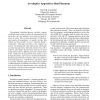Free Online Productivity Tools
i2Speak
i2Symbol
i2OCR
iTex2Img
iWeb2Print
iWeb2Shot
i2Type
iPdf2Split
iPdf2Merge
i2Bopomofo
i2Arabic
i2Style
i2Image
i2PDF
iLatex2Rtf
Sci2ools
IPPS
1996
IEEE
1996
IEEE
An Adaptive Approach to Data Placement
Programming distributed-memory machines requires careful placement of datato balance the computationalload among the nodes and minimize excess data movement between the nodes. Most current approaches to data placement require the programmer or compiler to place data initially and then possibly to move it explicitly during a computation. This paper describes a new, adaptive approach. It is implemented in the Adapt system, which takes an initial data placement, efficiently monitors how well it performs, and changes the placement whenever the monitoring indicates that a different placement would perform better. Adapt frees the programmer from having to specify data placements, and it can use run-time information to find better placements than compilers. Moreover, Adapt automatically supports a "variable block" placement, which is especially useful for applications with nearest-neighbor communication but an imbalanced workload. For applications in which the best data placement v...
Careful Placement | Data Placement | Distributed And Parallel Computing | Initial Data Placement | IPPS 1996 |
Related Content
| Added | 07 Aug 2010 |
| Updated | 07 Aug 2010 |
| Type | Conference |
| Year | 1996 |
| Where | IPPS |
| Authors | David K. Lowenthal, Gregory R. Andrews |
Comments (0)

